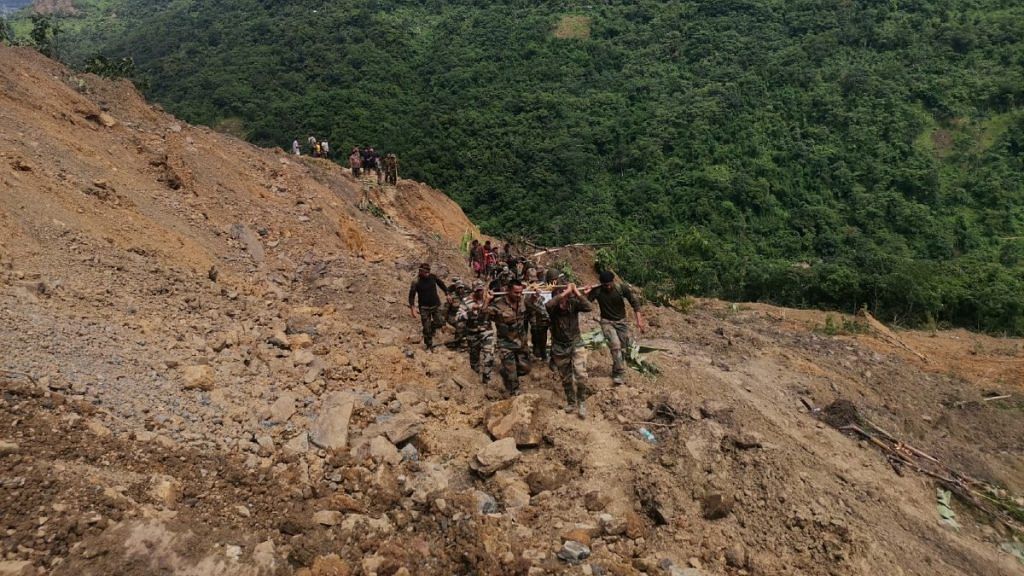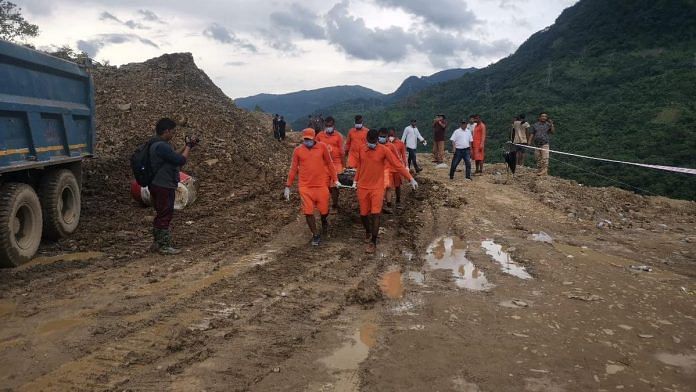Tupul/Imphal: A devastating landslide near the under-construction Tupul train station in Manipur’s hilly Noney district last week has raised questions about the ambitious 111-km Imphal-Jiribam railway project — part of the Trans-Asian Railway Network that aims to connect countries across the continent.
As of Sunday, rescue teams had recovered 42 bodies from the site of the landslide, while 20 remained missing.
The victims include several personnel of a Territorial Army camp that had been set up to protect the railway line being built from Jiribam district to Imphal, the capital of Manipur. When ThePrint visited the site last week, all that remained of the camp was a tin roof, hidden under layers of slush, providing a stark contrast to the lush environs.
In an interview with EastMojo, a northeast-focused media outlet, Manipur Chief Minister and BJP leader N. Biren Singh said the tragedy necessitated a “relook” at the railway project.
“The Manipur hill soil is very soft, the railway people have the expertise, but unfortunately this kind of incident has taken place and they need to relook… this target of railway reaching Imphal by December 2023 will be delayed,” he had said.
Meanwhile, residents of Makhuam village, which is situated a few kilometres from the site, have alleged that their inputs had not been sought prior to construction starting.
“Even after the Environmental Impact Assessment was done, the railway officials never met with us, there was no public consultation,” Jiandai Gangmei, secretary of the Makhuam village council, claimed to ThePrint.
“They cut the jungle — when we would ask them to replant it, they didn’t do it. They never took our advice on where to make the roads, how to drain the water, they didn’t make a wall either [as a protective measure],” he added.
According to the Environmental Impact Assessment notification of 2006, the environmental clearance process includes four stages: Screening, scoping, public consultation, and appraisal.
When asked about the local residents’ allegations, Sabyasachi De, chief public relations officer of the North East Frontier Railway, said: “The land when acquired was done after due consultation with the state machinery and the villagers.”
The project’s chief engineer Sandeep Sharma offered more details.
“We bought land from [villagers], and as a mandate… This [the consultation] is always done. But the scope would be limited to the part of the land where the station is being built.”
Some local residents are now demanding that the project should be stopped until detailed consultations with them take place.
Also Read: ‘I screamed to warn them, it was too late’ — devastation & despair day after Manipur landslide
‘They completely ignored us’
The broad-gauge railway line between Imphal and Jiribam is being built by the North East Frontier Railway to improve connectivity in the remote, undulating region. The Rs 14,000 crore project, which started in 2013, includes the construction of 46 tunnels and more than 150 bridges.
According to chief engineer Sandeep Sharma, the project is being built in three phases — the first from Jiribam to Vangaichungpao, the second from Vangaichungpao to Khongsang, and the third from Khongsang to Tupul.

The third phase of the project includes the Noney Bridge, which is slated to become the world’s tallest rail bridge.
The proposed Tupul railway station — where the landslide hit — is located close to the banks of the Ijei river, which snakes its way through hills in the district.
Connected to the site via a winding road in the hills is the village of Makhuam.
Residents here believe that, had they been consulted prior to construction, the landslide may have been prevented.
“The local residents know about the landscape, about the [natural] drainage system, how the river flows, where the loose soil and rock is. They have completely ignored us,” Gailengpou Gangmei, a resident of the village, told ThePrint.
He, like village council secretary Jiandai Gangmei, stressed the importance of the railways for the area, but said the project should not continue without public consultations.
“We want the railways to come here, it’s development and we need this connectivity for jobs too,” Gailengpou said. “But, before restarting, they should have a meeting with the local residents. If they don’t do that, then we will have to stop work.”
Sharma, meanwhile, said that public consultations had been done for “the part of the land” that had been bought from villagers, but not beyond that.
“The hill expands 600 metres beyond the railway point. The entire terrain will have so many mountains and there will be thousands of mountains that could affect the alignment here. That kind of analysis, which is one or two kilometres away from me, my project line, that we have not done really,” he said, adding that all cutting work on the hill was done after conducting a “slope analysis” and keeping “protective measures” in mind.
The Noney district administration, ThePrint has learnt, had back in 2017-2018 written to the Geographical Survey of India (GSI) over the dumping of excavated materials from the railway construction into the Ijei river.
An official with the GSI said on condition of anonymity that the district administration had written to the head of the department, who had sent two officers to see “what exactly happened”.
“At the location of the landslide, they had cut the hills in the middle for the railway track and there was dumping there. On top of the dumping materials, people were settled — railway officers, labourers, and [security personnel],” the official added.
According to Sharma, however, the GSI officials had been called primarily to check on the tunnel being built in Imphal, and that they had only briefly reviewed the Tupul project. “The hazard-mapping exercise can’t be taken up by GSI officials, it needs different expertise,” he said.
Heavy rainfall, deforestation may have heightened risk
The pace of deforestation in the area may have contributed to the landslide, some experts believe.
“The clearance of the forest for the railway connectivity was taking place at a very fast rate. Additionally, heavy rainfall has also had an impact,” Dr Brajakumar Singh, joint director at the Directorate of Environment and Climate Change in Manipur, said.
According to Singh, Tamenglong and Noney districts had received up to 300 mm of rainfall in a single day in May.
“Due to the heavy rainfall and the fast rate of deforestation, the soil stability had been disturbed, especially because the mountains in these parts are young. That’s our observation,” he said.
Rajesh Salam, a Manipur-based environmentalist, voiced similar concerns.
“I had visited the site three to four years ago. From a layman’s perspective, it seemed that they had not taken any protective measures. I had also asked the chief engineer about how they were planning to manage the stormwater given the heavy rainfall,” Salam said.
When asked about this, Sharma said that excess rainwater was dealt with appropriately.
“If we try to block [water], it would create a problem… we have a special protection system (including troughs) which carries it down peacefully to the river and we do it with every bridge,” Sharma said.
An earthquake in January 2016 may also have made the area more vulnerable, the chief engineer added.
“In 2016, there was a massive earthquake about 5km from Tupul. It might have created a lot of shivers in Tupul and because of the jhum (slash-and-burn) cultivation and deforestation of the topsoil, the water started percolating in the hills… as a result the land sliced off like butter,” Sharma said.
For now, according to Sharma, the “way forward” will be a three-fold process.
“First of all is to recover the dead bodies, then dredge the river, and then review the entire project in the light of this,” he said.
(Edited by Asavari Singh)
This article has been updated to reflect the correct name of the chief public relations officer of the North East Frontier Railway.
Also Read: Another year, another deluge in Assam — why northeast floods are getting grimmer



